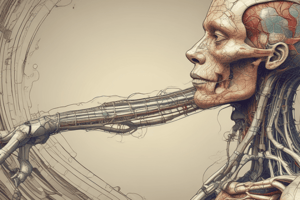Podcast
Questions and Answers
What are the implications of neglecting certain topics in a subject?
What are the implications of neglecting certain topics in a subject?
- It will certainly improve exam performance.
- It reduces the complexity of the subject matter.
- It may lead to misconceptions. (correct)
- It can enhance overall understanding.
How does a comprehensive review benefit learning?
How does a comprehensive review benefit learning?
- It distracts from important subjects.
- It ensures students can skip difficult topics.
- It guarantees mastery of all concepts.
- It can identify knowledge gaps. (correct)
Which strategy is least effective in retaining information?
Which strategy is least effective in retaining information?
- Using mnemonic devices.
- Regular practice and revision.
- Ignoring difficult concepts. (correct)
- Active participation in discussions.
What role do assessments play in the learning process?
What role do assessments play in the learning process?
Which element is crucial for effective learning outcomes?
Which element is crucial for effective learning outcomes?
Flashcards
This indicates the beginning of a section of text, usually a new chapter or topic.
To be continued
To be continued
The act of leaving a piece of writing or work unfinished for a period of time.
Categorization
Categorization
A way to organize information, where items are grouped together based on their common characteristics.
Blank space
Blank space
Signup and view all the flashcards
Slip
Slip
Signup and view all the flashcards
Study Notes
Parasympathetic Nervous System Actions
- Constricts pupils
- Stimulates saliva secretion
- Slows heartbeat
- Constricted bronchi
- Stimulates digestion
- Stimulates liver to release bile and insulin
- Stimulates intestinal peristalsis and secretion
- Contracts bladder
Sympathetic Nervous System Actions
- Dilates pupils
- Inhibits saliva secretion
- Accelerates heartbeat
- Relaxes bronchi
- Inhibits digestion
- Stimulates liver to release glucose
- Inhibits intestinal peristalsis and secretion
- Relaxes bladder
Autonomic Nervous System Actions
- Regulates involuntary bodily functions (heart rate, blood pressure, respiration, digestion, gland secretion)
- Operates subconsciously, maintaining homeostasis and responding to internal and external changes
- Divided into sympathetic and parasympathetic divisions
Adrenergic Receptors
- Alpha 1 receptors: located in smooth muscle, blood vessels, radial muscles (eyes, etc), urinary bladder. Increases force of heart contraction, vasoconstriction, mydriasis, decreased salivary secretions, urinary sphincter contraction.
- Alpha 2 receptors: located presynaptically on adrenergic nerve terminals. Inhibits NE release, dilates blood vessels, lowers blood pressure, decreases gastrointestinal motility.
- Beta 1 receptors: located primarily in the heart & kidneys. Increases heart rate, force of contraction, increase renin release.
- Beta 2 receptors: located in smooth muscles of lungs, blood vessels supplying skeletal muscle, liver. Produces bronchodilation, relaxation (uterus, gastrointestinal tract), vasodilation.
- Beta 3 receptors: primarily in adipose tissue. Initiates lipolysis (fat breakdown)
Neurotransmitters
- Acetylcholine (ACh): primary neurotransmitter for parasympathetic system
- Norepinephrine (NE): primary neurotransmitter for sympathetic system
- Epinephrine: released from the adrenal medulla, part of the sympathetic system
Drugs Affecting the Nervous System
- Stimulants (Psychostimulants): increase dopamine and norepinephrine release.
- Effects: heightened alertness, increased energy, improved concentration, increased focus.
- Examples: Amphetamines, caffeine, cocaine
- Depressants: reduce CNS activity, leading to calming and sedative effects.
- MOA: enhance GABA activity, the primary inhibitory neurotransmitter.
- Effects: Muscle relaxation, anxiety reduction, sleep induction.
- Examples: Benzodiazepines, barbiturates, alcohol
- Opioids: act primarily on opioid receptors to produce pain relief.
- MOA: Inhibit pain pathways and increase dopamine release.
- Effects: Analgesia (pain relief), sedation, euphoria
- Examples: Morphine, codeine, fentanyl, oxycodone
- Hallucinogens (Psychedelics): alter perception, mood, and cognitive processes.
- Effects: Distorted reality perception, hallucinations, altered thought processes.
- Examples: LSD, psilocybin, MDMA
- Antidepressants: affect neurotransmitters (serotonin/ norepinephrine) to improve mood.
- MOA: Block serotonin reuptake, increasing serotonin availability.
- Examples: SSRIs (e.g., fluoxetine), SNRIs (e.g., venlafaxine), tricyclic antidepressants, MAOIs
- Antipsychotics: block dopamine receptors to reduce psychotic symptoms.
- Effects: Reduction in psychotic symptoms (hallucinations, delusions).
- Examples: Haloperidol, risperidone, olanzapine
Studying That Suits You
Use AI to generate personalized quizzes and flashcards to suit your learning preferences.




